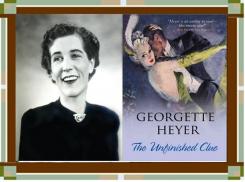Our “back to school” on the mystery genre session featured Georgette Heyer’s The Unfinished Clue. Heyer was picked for her mastery of the classic British country mansion murder form. An integral part of the mystery genre, we’re more familiar with the Golden Age mystery writers who used it – such as Agatha Christie, Dorothy L. Sayers, Ngaio Marsh, and Margery Allingham. Heyer is better known for her wonderful Regency novels, but her husband encouraged her to try her hand at mystery – and she succeeded splendidly.
We liked the way she stayed true to the form in terms of characters, setting, and most especially, dialog. There’s no mistaking that this is a truly British crime committed by characters who are well within the upper class. The fun part is that it’s the upper class as it was in the early post-war years, so we could talk about how the two World Wars had impacted just how such an estate as The Grange was being run. Among these post-war issues: a lack of servants, lack of grounds workers, workers griping and quitting, and the working class in villages – turning to better paying jobs in the city.
While we weren’t crazy about Fay, we sympathized with her being under the thumb of the obnoxious, abrasive, domestic bully, know as General Sir Arthur Billington-Smith. He is most understandably, the murder victim – and there are plenty of suspects among the weekend guests.
Inspector Harding is relieved that the one person who could not have done the murder is Fay’s likeable, no-nonsense sister, Dinah Fawcett. We were split on whether this romantic element was handled well. Some thought there hadn’t been enough interaction between them to make a relationship believable, and others thought that this aspect was suited to both the British background of the characters (expressing themselves with reserve) and fit the kind of relationship short-hand that British authors of the era (particularly in mystery) tended to use. We speculated that handling romance this way keeps it from taking over the mystery – which is supposed to be the focus.
We also talked about how skillfully Heyer uses dialog to forward the action, reveal aspects of character, and hide clues. Most of the clues to the changing relationship between Harding and Miss Fawcett are conveyed in their dialog. The character of the inimitable Lola is completely revealed in what she has to say and how she says it.
In all, the group had an enjoyable time visiting a time and place where you could curl up with a book like this and a good cup of tea and have a cracking puzzle to solve!






Add new comment